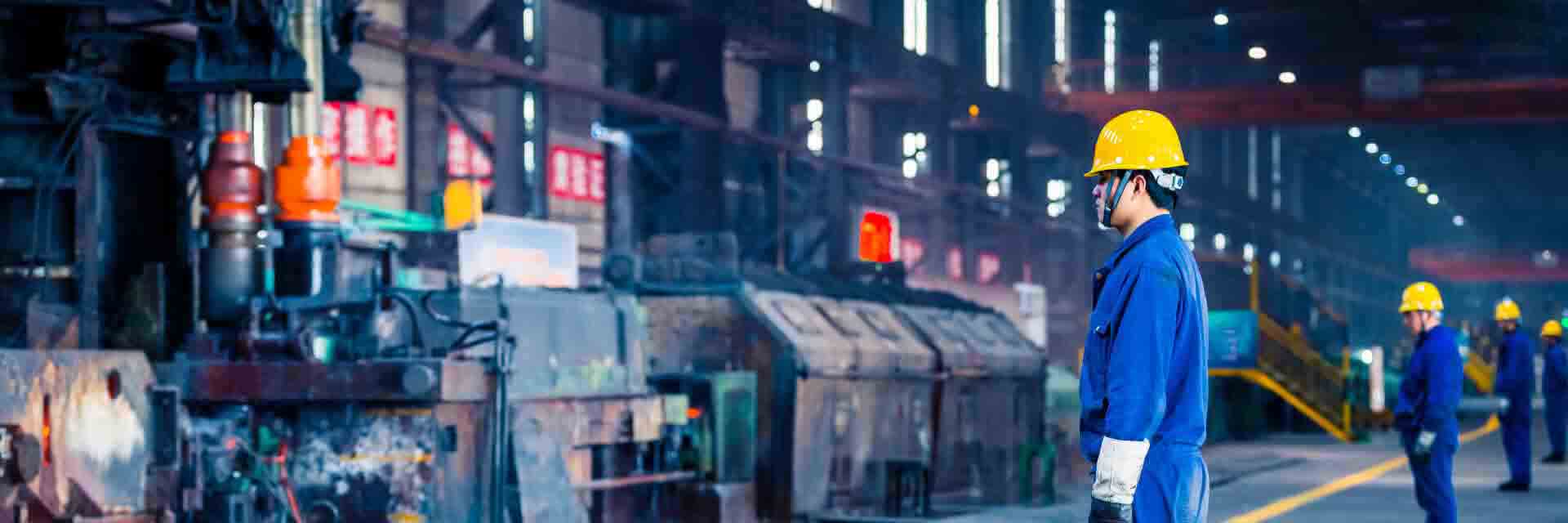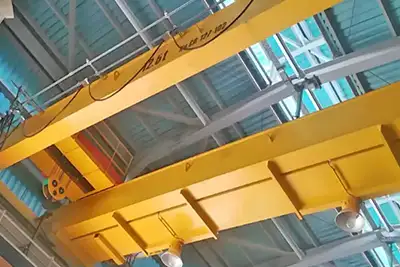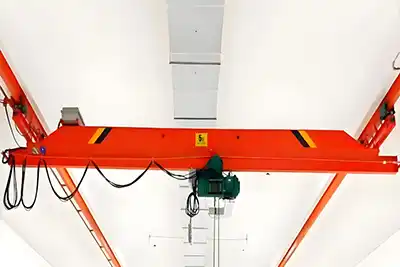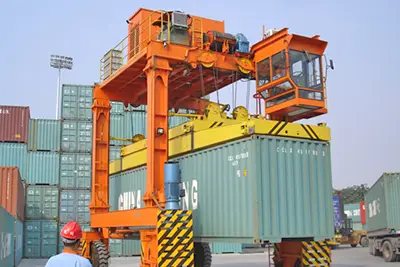22/5 Ton European Overhead Crane for Phillipines, Load Testing
Case Study: 22/5 Ton European-Style Overhead Crane for the Philippines – Customized Design, Full Load Testing, and Ready for Delivery
This project centers around a custom-built 22/5 ton European-style double girder overhead crane, manufactured for a client in the Philippines. The crane is designed for handling heavy equipment and components in a compact indoor or semi-outdoor facility, where lifting accuracy and safety are high priorities.
The crane system features a 22-ton main hook for heavy lifting and a 5-ton auxiliary hook mounted on the same trolley, providing greater flexibility for load rotation, fine positioning, or dual lifting operations. It spans 10.9 meters with a 15-meter lifting height, tailored to fit within the customer’s existing workshop structure without needing runway modifications. The system runs on a 400V, 60Hz, 3-phase power supply to match local grid standards in the Philippines.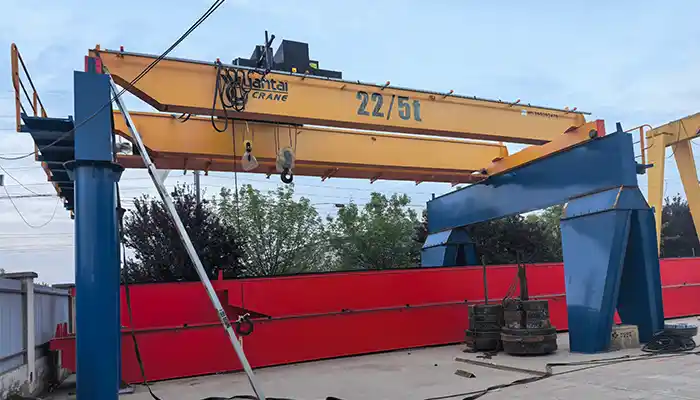
European style overhead crane double girder with main hook and auxiliary hook for sale
This project highlights several key aspects:
- Customization
The crane was engineered to meet site-specific needs, including compact span, dual hoist setup, and FEM 2m (ISO M5) working duty—ideal for medium to high frequency lifting cycles. - Quality Control
Material selection, welding, assembly, and electrical systems were all inspected under a strict QA process. Non-destructive tests (UT and MT) were applied to critical structural welds. Each drive and control component was bench-tested before integration. - Full Load Testing
The crane successfully passed both static (125%) and dynamic (110%) load tests. The main hoist lifted 27.5 tons under full travel and holding conditions, while the auxiliary hoist passed its overload checks at 6.25 tons. All motions—including hoisting, lowering, cross travel, and long travel—were tested under full load. Limit switches, brake systems, and safety features responded within expected tolerances.
Current Project Status:
The crane is now fully assembled, tested, and ready for dispatch to the Philippines. All quality inspection reports, operation manuals, and electrical drawings have been compiled into the delivery package. A testing video showing the crane’s performance under full load conditions is also available and shared with the client for pre-shipment review.
This project stands as a dependable lifting solution tailored to the customer’s site and operational requirements—delivered with precision, care, and full transparency.
Project Background
This overhead crane project was commissioned by a client based in the Philippines, serving a manufacturing facility that handles heavy components and assemblies daily. The client’s industry requires reliable and efficient material handling equipment to keep production flowing smoothly and safely.
Industry Use:
The crane will primarily support heavy component handling tasks—such as moving large steel plates, machinery parts, and tooling fixtures—within a workshop environment. The facility demands equipment that can handle both large loads and precise positioning for assembly or fit-up processes.
Customer Requirements:
- High-capacity main hoist:
The customer needed a robust 22-ton main hook capable of lifting heavy materials safely and reliably. This capacity supports the heaviest parts in their workflow and ensures flexibility for future heavier lifts. - Secondary auxiliary hoist:
In addition to the main hoist, a 5-ton auxiliary hook was required to handle lighter loads, perform tilt or rotation tasks, or manage dual lifting scenarios where two points of attachment improve load stability and safety. - Compact footprint:
Space constraints within the facility meant the crane had to fit within an existing structure without requiring costly runway beam changes or modifications. The 10.9-meter span and 15-meter lifting height were designed to maximize the working envelope while minimizing structural alterations. - Precise lifting performance:
The client emphasized the need for smooth and controlled load handling, especially during positioning or fit-up operations. Features like VFD-controlled hoisting speeds, micromovement modes, and anti-sway control were essential for meeting these precision demands.
Summary of Project Objectives:
- Increase Productivity:
The crane’s dual-hoist setup and smooth controls are aimed at reducing cycle times, speeding up material movement, and allowing simultaneous handling of multiple load types. - Ensure Long-Term Reliability:
By selecting a European-style double girder design with proven components and applying rigorous quality assurance, the client expects years of dependable operation with minimal downtime. - Future-Proof Design:
The crane was engineered with enough capacity margin and modular features to accommodate potential future needs—such as higher loads or automation upgrades—without requiring a full replacement.
This clear understanding of the client’s environment and goals shaped every stage of the crane’s design and production, ensuring a tailored solution that meets both current and long-term needs.
Technical Specifications of the Overhead Crane
This overhead crane has been designed with precision and durability in mind, following the European-style double girder configuration to meet the client’s operational demands.
- Crane Type:
European-style double girder overhead crane, known for its strength, stability, and ability to handle heavy loads with minimal deflection. - Main Hoist Capacity:
Rated at 22 tons, the main hoist is built to handle the facility’s heaviest materials, providing reliable lifting power and smooth operation. - Auxiliary Hoist Capacity:
The auxiliary hoist has a 5-ton capacity, ideal for lighter loads, tilt, rotation, or secondary lifting tasks, adding operational flexibility. - Span:
The crane spans 10.9 meters, designed specifically to fit the existing building layout without requiring structural modifications. - Lifting Height:
The crane offers a 15-meter lifting height, sufficient to clear the tallest fixtures and allow safe truck or forklift passage underneath. - Power Supply:
Equipped to run on 400V, 60Hz, 3-phase power, aligning perfectly with the standard electrical grid of the Philippines, which avoids the need for additional transformers or converters. - Duty Class:
Rated FEM 2m / ISO M5, this crane is classified for medium to heavy duty with regular operation cycles, suitable for high-use industrial environments. - Hoisting Speed:
Hoisting motions are controlled via Variable Frequency Drive (VFD), providing smooth start and stop actions, reducing mechanical stress, and improving positioning accuracy. - Travel Mechanism:
The crane is equipped with motorized cross and long travel motions, featuring either VFD control or two-speed motors, ensuring precise and efficient movement along the runway. - Control Mode:
The crane can be operated using a remote control system for flexibility and safety, with an optional pendant control for direct operator interaction when needed.
These specifications collectively deliver a lifting system tailored to the client’s operational environment, balancing power, precision, and safety.
Customized Crane Design Approach
The design of this overhead crane was carefully tailored to meet the client’s specific operational needs and site conditions. Here’s why and how the design choices were made:
Why Choose a Double Girder European-Style Crane?
The double girder design offers several advantages over single girder cranes, especially for heavy-duty applications like this:
- Greater load capacity and higher lifting heights
- Improved stability and reduced girder deflection under heavy loads
- Easier to integrate larger or multiple hoists
- Better clearance between hook and bridge, allowing more versatile lifting options
European-style cranes are also known for their compact, efficient design and use of standardized components, making them reliable and easier to maintain.
Design to Match Compact Site Layout and Span
The crane’s 10.9-meter span was precisely engineered to fit within the customer’s existing building columns and runway beams. This avoided the need for costly structural modifications or runway rebuilds. The design maximizes available workspace without compromising safety or performance.
Main and Auxiliary Hooks on the Same Trolley
By mounting the 22-ton main hook and 5-ton auxiliary hook on the same trolley, the crane gains significant operational flexibility:
- Operators can switch between heavy lifting and lighter, more precise movements without changing equipment
- Dual hook setup allows for complex load handling like tilting or rotation without additional machinery
- Reduces downtime by avoiding the need to switch cranes or attachments for different tasks
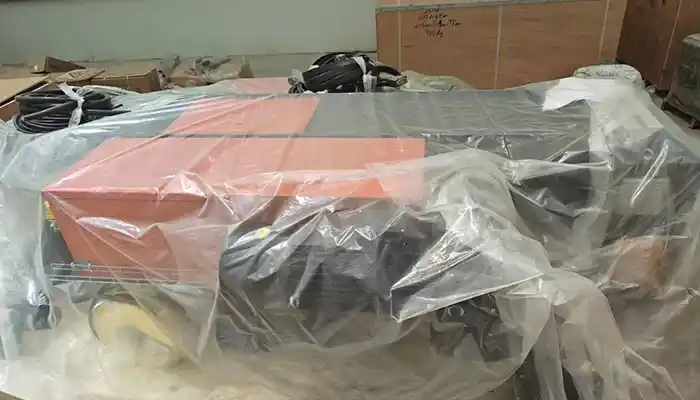
Compliance with CE & ISO Standards
The crane meets strict European CE and ISO certifications, ensuring that it adheres to global safety, quality, and performance standards. This certification assures the client of the crane’s reliability and compliance with international industrial regulations.
Robust Structural Design
The crane’s steel structure was engineered for durability and safety:
- Deflection under full load is limited to L/800 or less, keeping the bridge rigid and minimizing vibrations during lifting
- All welds and joints are designed for fatigue resistance, ensuring long service life even under frequent heavy use
- Finite Element Analysis (FEA) was used during design to verify stress distribution and structural integrity
Corrosion-Resistant Coating for Coastal Environment
Considering the Philippines’ humid and coastal climate, the crane received a high-quality, corrosion-resistant paint finish:
- Protects steel surfaces from rust and environmental wear
- Extends the lifespan of the crane components
- Minimizes maintenance needs in harsh weather conditions
Together, these design choices provide a tailored, dependable crane solution optimized for the client’s operational, environmental, and safety requirements.
Factory Load Testing – 100% + 125% Trial
Before shipping, the crane underwent a thorough load testing program at the manufacturing facility to ensure it meets all safety and performance standards. This rigorous testing process confirms the crane’s readiness for heavy-duty operations.
Test Setup:
All tests were performed under controlled conditions at the factory. The crane was fully assembled and operated with test loads carefully applied and monitored by experienced engineers and quality inspectors. Both internal QA personnel and third-party inspectors supervised the process.
Static Load Test (125% of Rated Load = 27.5 tons):
- The crane’s main hoist lifted 27.5 tons, which is 125% of its 22-ton rated capacity.
- The load was held steady at the maximum lifting height of 15 meters for over 10 minutes.
During this period, critical checks included:
- Monitoring structural deflection of the girders and trolley
- Verifying the functionality and holding power of brakes under full load
- Observing overall structural behavior for any signs of stress or deformation
Dynamic Load Test (110% of Rated Load = 24.2 tons):
The crane was tested under moving load conditions with 24.2 tons applied on the main hoist.
Tests included:
- Hoisting and lowering cycles to simulate normal lifting operation
- Cross-travel and long-travel motions while carrying the load to check smoothness and stability
These tests verify:
- The motor and drive system’s ability to handle dynamic forces
- Control system responsiveness for speed and positioning accuracy
- Overall system stability during operation with heavy loads
Auxiliary Hook Test:
- The 5-ton auxiliary hoist was tested with a 6.25-ton test load (125% overload).
- The auxiliary hoist successfully handled the overload without any issues, confirming its reliability for lighter lifting tasks or dual load handling.
Test Results:
- The crane passed all performance and safety criteria during both static and dynamic testing phases.
- Tests were witnessed and approved by third-party inspectors as well as the factory’s internal QA team, ensuring transparency and compliance with international standards.
Supporting Media:
- A detailed testing video documenting these load tests is available and has been shared with the client.
- This video provides visual confirmation of the crane’s performance and helps the customer verify the quality before shipment.
This comprehensive load testing phase guarantees that the crane will operate safely and effectively from day one at the customer’s site.
Quality Assurance & Documentation
Ensuring the highest quality and reliability was a key focus throughout the crane’s manufacturing process. Every step was documented and verified to meet industry standards and client expectations.
Material Traceability for Steel:
- All steel components used in the crane’s structure come with full material certification and traceability.
- This means every batch of steel can be tracked back to its source, including chemical composition and mechanical properties, ensuring consistent quality and compliance with relevant standards.
- Traceability helps guarantee that no substandard or unverified materials enter the production process.
Weld Inspections – Ultrasonic Testing (UT) & Magnetic Particle Testing (MT):
Critical welds on girders, joints, and trolley frames underwent non-destructive testing (NDT) methods:
- Ultrasonic Testing (UT) was used to detect internal flaws or discontinuities in welds that aren’t visible to the naked eye.
- Magnetic Particle Testing (MT) was applied to surface welds to identify cracks or surface defects.
These inspections ensure structural integrity and long-term durability under heavy loads.
Electrical and Safety Device Testing:
- All electrical components, including motors, drives, controllers, limit switches, and safety devices such as overload limiters and emergency stops, were thoroughly tested before integration.
- Tests verified correct wiring, insulation resistance, response time, and fail-safe operation under fault conditions.
- This step guarantees that the crane’s electrical system meets safety and performance requirements.
Full Documentation Provided:
- Test Reports: Detailed records from all load tests, material inspections, and electrical tests are compiled into comprehensive reports. These documents provide the client with full transparency regarding the crane’s performance and quality.
- Factory Acceptance Test (FAT) Checklist: A formal FAT checklist shows each step of inspection and testing performed before shipment, signed off by quality engineers and inspectors. This checklist acts as an official confirmation of the crane’s readiness.
- User Manuals and Electrical Drawings:
Complete operational manuals explain how to safely operate, maintain, and troubleshoot the crane. Electrical schematics provide essential information for electricians and service technicians during installation and future repairs. - Spare Parts List: A detailed list of recommended spare parts is included, helping the customer maintain the crane efficiently and minimizing downtime in case of component wear or failure.
This comprehensive quality assurance and documentation package not only confirms the crane’s reliability but also equips the customer with all the tools and information needed for safe, effective operation and maintenance.
Packing, Delivery & Next Steps
The final stage before the crane reaches the customer involves careful preparation, logistics planning, and ongoing support to ensure a smooth transition from factory to operational site.
Packing for Safe Transit:
- All crane components are packed securely with seaworthy wrapping to protect against moisture, salt air, and rough handling during ocean freight.
- The packing method is optimized to maximize container space, reducing shipping costs while keeping parts stable and well-protected.
Delivery Schedule Coordination:
- The delivery timeline is carefully planned to match the customer’s site readiness, minimizing storage time and potential delays.
- Regular communication keeps the client updated on shipment status, estimated arrival, and customs clearance processes to ensure smooth handover.
Optional On-Site Support:
To guarantee correct assembly and safe operation, the manufacturer offers the option to dispatch a technical team to the Philippines.
This team can assist with:
- Installation and erection of the crane on the customer’s runway system
- Electrical hook-up and testing at the site
- Operator training sessions, covering safe crane operation, daily inspections, and emergency procedures
Delivery of Documentation and Testing Video:
Prior to shipment, the client receives:
- A comprehensive testing video showcasing the crane’s load tests and operational checks conducted at the factory. This visual proof supports confidence in the equipment’s performance.
- A digital package of all documentation, including manuals, certifications, test reports, and electrical drawings for review and preparation ahead of delivery.
By carefully managing packing, delivery, and after-sales support, the project team ensures the crane arrives safely and the customer is fully prepared for installation and operation. This proactive approach helps reduce risks and accelerates time to productivity.
Conclusion
This project successfully delivered a reliable, custom-built overhead crane designed specifically to meet the client’s unique needs. Every step—from design and engineering to manufacturing and testing—was executed with precision to ensure a high-quality, durable lifting solution.
Key Highlights:
- Dual-Hook Functionality: The crane features both a 22-ton main hook and a 5-ton auxiliary hook on the same trolley, providing flexible lifting options for a wide range of tasks.
- European-Style Double Girder Design: Chosen for its robustness, stability, and suitability for heavy-duty applications, this design also optimizes space and load handling efficiency.
- Verified Load Performance: Comprehensive static and dynamic load tests at 125% and 110% of rated capacity confirm that the crane meets or exceeds safety and operational standards.
Yuantai Crane’s Commitment:
- Throughout the project, Yuantai Crane has maintained a strong focus on quality assurance, ensuring every material and component complies with international standards.
- The company prioritizes safety features and certifications to guarantee secure operation in demanding environments.
- On-time delivery and responsive customer support have been central, reflecting Yuantai’s dedication to meeting client expectations without compromise.
With the crane now ready for shipment and full documentation provided, Yuantai Crane looks forward to supporting the client through installation, commissioning, and ongoing operation. This project stands as a clear example of delivering tailored, dependable crane solutions that keep industrial operations moving safely and efficiently.

